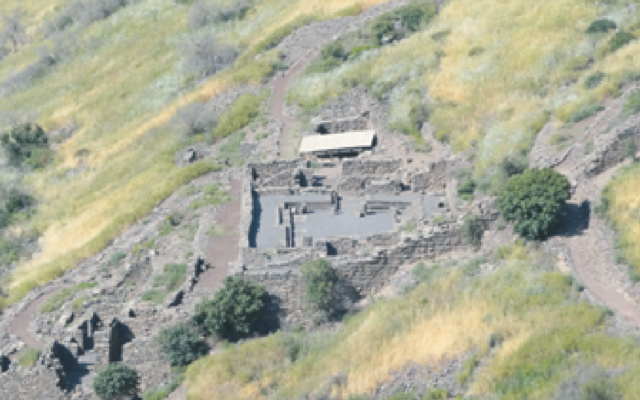The Golan – an area intrinsic to Israel
There is actually so much more to our claim to the Golan than simply meeting security needs.
If ever there were grounds to query Israel’s need to hold on to the Golan area consider the recently uncovered Syrian military bunker on the Golan Heights that had been abandoned following the 1967 Six-Day War.
As reported in Times of Israel (November 2, 2021) in the name of Israel’s Ministry of Defence, the bunker, near an outpost used by the Syrian military to shoot at communities in the Hulah valley, was full of hundreds of pieces of ordnance, including mortar shells of different calibres, flares, pyrotechnic munitions, explosives, hunting rifle ammunition and others inside their original packages or spread out. It provided further clear evidence of the inevitable dangers to Israel (not that proof was needed) if the area overlooking the Galilee panhandle and the Kinneret, was returned to Syria.
No wonder that even while casting doubt on the legality of the Trump administration’s decision to recognise Israeli sovereignty over the strategic plateau, Secretary of State Antony Blinken said: “Look, leaving aside the legalities of that question, as a practical matter, the Golan is very important to Israel’s security.”
Despite the Syrian situation, the United Nations General Assembly votes each year demanding return of the Golan to Syria. Leaving aside the issues underlying demands for Israel to withdraw from other areas taken in 1967, an additional factor in regard to the Golan is that it was not part of the area of Mandatory Palestine that was the subject of the November 1947 Partition resolution. Establishment of a territory that became known as Palestine was foreshadowed in the 1916 Sykes/Picot agreement between Britain and France that was the initial step in carving up the formerly Ottoman territories in the Middle East. Though the post-war San Remo Conference, that largely followed Sykes/ Picot principles, did not exclude all of the Golan from the Jewish Homeland in Palestine as referred to in the Balfour Declaration, Britain ceded the area to France in the Franco-British Agreement of March 7, 1923. This move placed the Golan in the French mandated territory that subsequently became Syria.
So military defence issues aside what claim does Israel have to the Golan Heights? The answer is the extent of the rich Jewish history in the area known from many sources, that is increasingly being corroborated by archaeological work.
In Devarim (3:1-7) we find that B’nei Israel conquered the Golan from the Amorites. Following entry into the Land, the tribe of Menashe settled in the Bashan area (Joshua 13:29-31). The city of Golan became one of the three cities of refuge established east of the Jordan.
In First Temple times (953-586 BCE), the area was contested between the northern Jewish kingdom of Israel and the Damascus-based Aramean kingdom. King Ahab defeated Ben-Hadad of Damascus near Afeq in the southern Golan (I Kings 20:26-30).
As part of the return to the land following the first exile, returning exiles also settled in the region. Apocryphal writings (see I Maccabees 5) record that in the mid-2nd century BCE, Judah Maccabee came to the aid of the local Jewish communities under attack from their non-Jewish neighbours.
Gamla became the Golan’s chief city and as recorded by Josephus was the area’s last Jewish stronghold to resist the Romans during the Great Revolt, falling in the year 67. Archaeological ruins testify to its greatness. Nevertheless, Jewish communities on the Heights continued, and even flourished through subsequent centuries. The remains of at least 25 synagogues from the period between the Revolt and the Islamic conquest in 636 have been excavated; many can easily be visited by tourists as can other reconstructed sites illustrating early Jewish life in the area such as the reconstructed village of Katzrin.
However the end of Jewish settlement was in sight following the August 636 battle fought in the Yarmouk Valley on the southern edge of the Heights, whereby Caliph Omar established Islamic control over what is now Israel, Jordan, Lebanon and Syria. And then what remained finally came to an end in 749 when a severe earthquake ravaged the area from the southern Arava region to the Hulah Valley. According to ancient chronographers, tremors were felt all the way from Damascus to Cairo. The disaster was enough to wipe out a number of urban population centres as well as groups of isolated communities at the epicentre of the quake. To this day archaeologists investigating the results of that disaster in the Golan region are uncovering clear evidence of the Jewish life there that preceded it.
In the 15th century, Druze began to settle in the northern Golan and on the slopes of Mount Hermon. The Jewish presence on the Golan was renewed in 1886/7, when the B’nei Yehuda society of Tzfat purchased land including an area near the modern-day Kibbutz Ein Gev on the eastern shore of the Kinneret. This community survived until 1920, when two of its last members were murdered in anti-Jewish riots. In 1891, Baron Rothschild purchased approximately 18,000 acres of land about 15 km east of Ramat Hamagshimim, in what is now Syria. First Aliyah immigrants established five small communities on this land, but were forced to leave by the Turks in 1898. Though some of those lands continued to be farmed by the Palestine Colonisation Association they were seized by the Syrian army in 1947. It would be two decades until Jews returned to any area of the Golan.
Indeed the connection between Jews and the Golan spans millennia.
Shabbat shalom,
Yossi
Yossi Aron OAM is The AJN’s religious affairs editor


comments